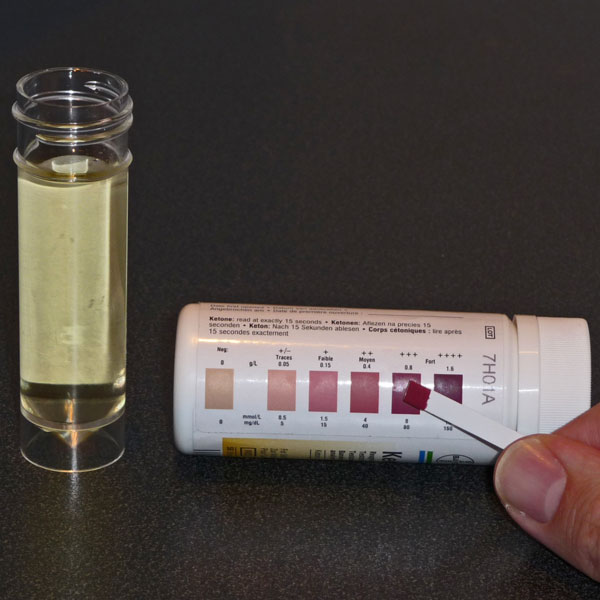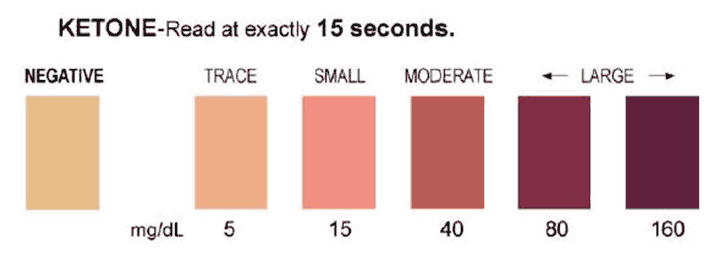UDA Training: Hyperglycemia
Diabetes Aide TrainingComplete all of the following modules:
As you complete this training course the RN responsible for delegating the task of insulin administration should be available to discuss the content and answer your questions.
Hyperglycemia
What is hyperglycemia?
Hyperglycemia is a high level of glucose in the blood or "high blood sugar".
When should we do something about it?
Hyperglycemia is when a person’s blood glucose level is greater than their individualized desired goal. Because each person is unique, a person’s physician usually provides specific directions in the student's Diabetes Medical Management Plan (DMMP) or the patient's orders as to when to consider a person to be having a high blood glucose. For example some people may be treated for a high blood sugar of 240 while another may not need additional treatment until their blood glucose is over 300. Check with your delegating RN to determine what is considered to be a "high blood sugar" for your student/patient.
What are the complications of having high blood sugars?
High blood sugars can be dangerous if left untreated and over time people with diabetes may develop complications as a result of having high blood sugars. A complication people with type 1 diabetes can develop is diabetic ketoacidosis (DKA), similarly, people with type 2 diabetes can develop a complication called hyperosmolar hyperglycemic nonketotic syndrome (HHNKS). Both DKA and HHNKS are serious and potentially life threatening situations.
How often do people get DKA or HHNKS?
Both DKA and HHNKS are rare conditions so you may never see a student or patient develop these syndromes. But because they are serious situations it is important for you to know about them so that you can also help detect symptoms.
Why do people develop hyperglycemia and sometimes DKA and HHNKS?
- They do not know they have diabetes so their blood sugars keep rising until they start to experience symptoms. Once they show symptoms, the newly diagnosed person with diabetes will be treated.
- They didn’t take enough insulin.
- They miss a dose of insulin.
- The insulin pump is not working right.
- They eat more food than they anticipated (they had a large meal or extra snacks).
- They used expired insulin.
- They are being stressed, such as with an illness or infection.
- They are having hormone fluctuations.
What is HHNKS?
HHNKS, or Hyperosmolar Hyperglycemic Nonketotic Syndrome, is the result of severe dehydration due to long term high blood sugars. People with type 2 diabetes may develop this rare condition which usually develops in the elderly and often in people that are not aware they have diabetes.
What are the symptoms of HHNKS?
- Hyperglycemia (high blood sugar)
- Thirsty, drinking more than usual
- Using the bathroom to urinate more often
- Dehydration
- Confusion
- Unconsciousness/coma
What is the treatment for HHNKS?
The goal of hyperglycemia (high blood sugar) treatment is to lower the blood sugar and keep the person from getting dehydrated. This usually requires extra insulin and fluids. Treatment may depend on how high the blood sugar is, if ketones are present and what symptoms are present.
Anytime hyperglycemia (high blood sugar) occurs it is important to notify the RN, encourage calorie free liquids, and closely follow the physician orders and/or student’s DMMP.
Diabetic Ketoacidosis (DKA)
DKA is the rare condition that develops as a result of high blood sugars in people with type 1 diabetes; often they are not aware they have diabetes. DKA is the result of the buildup of acid in the blood stream. This acid develops when the body has to use fat for energy rather than sugar. As this acid builds up it can cause abdominal pain, nausea and vomiting. This is a very serious situation! If insulin is not given the person with diabetes can die.
What are the symptoms of DKA?
- Hyperglycemia (high blood sugar)
- Thirsty, drinking more than usual
- Using the bathroom to urinate more often
- Fatigue, seem to tire out easily
- Ketones in the urine
- Nausea (feel sick to stomach)
- Stomach cramps or abdominal pain
- Vomiting
- Breath smells fruity
- Breathing more rapidly
- Confusion
- Unconsciousness (won’t respond to you)
If you notice these symptoms notify the RN. Check the person’s blood glucose level if possible and urine for ketones. Refer to the physician’s orders or the Diabetes Medical Management Plan (DMMP) to know when to test for ketones.
What are ketones?
Ketones, a type of acid, are a waste product of the body after it breaks down fat for energy.
When are ketones produced?
The body only uses fat and muscle tissue for energy when it cannot use glucose (sugar). This happens when there is not enough insulin available in the body such as during illness or times of stress. When the body does use fat and muscles, ketones are produced.
What happens when ketones are produced?
A person with diabetes may go into DKA (diabetic ketoacidosis) which is a serious and life-threatening condition that may require hospitalization! It is important to detect if ketones are present and to provide the appropriate treatment.
How are ketones detected?
A simple urine test is used to determine if ketones are present. Check the physician orders or Diabetes Medical Management Plan (DMMP) to find out when ketones need to be checked.
Follow these steps to check the urine for ketones.
| Generally, a private area that is close to a bathroom. | |
| Verify expiration date on ketone test strips. Strips should be discarded 6 months after opened. A disposable pad may be necessary to help protect the testing area. |
|
|
This requires that you be present in the bathroom with the person who has diabetes. |
| The ketone result will be Negative, Trace, Small, Moderate or Large. | |
| RN notifies physician or direct actions to be taken according to physician orders or DMMP. |


